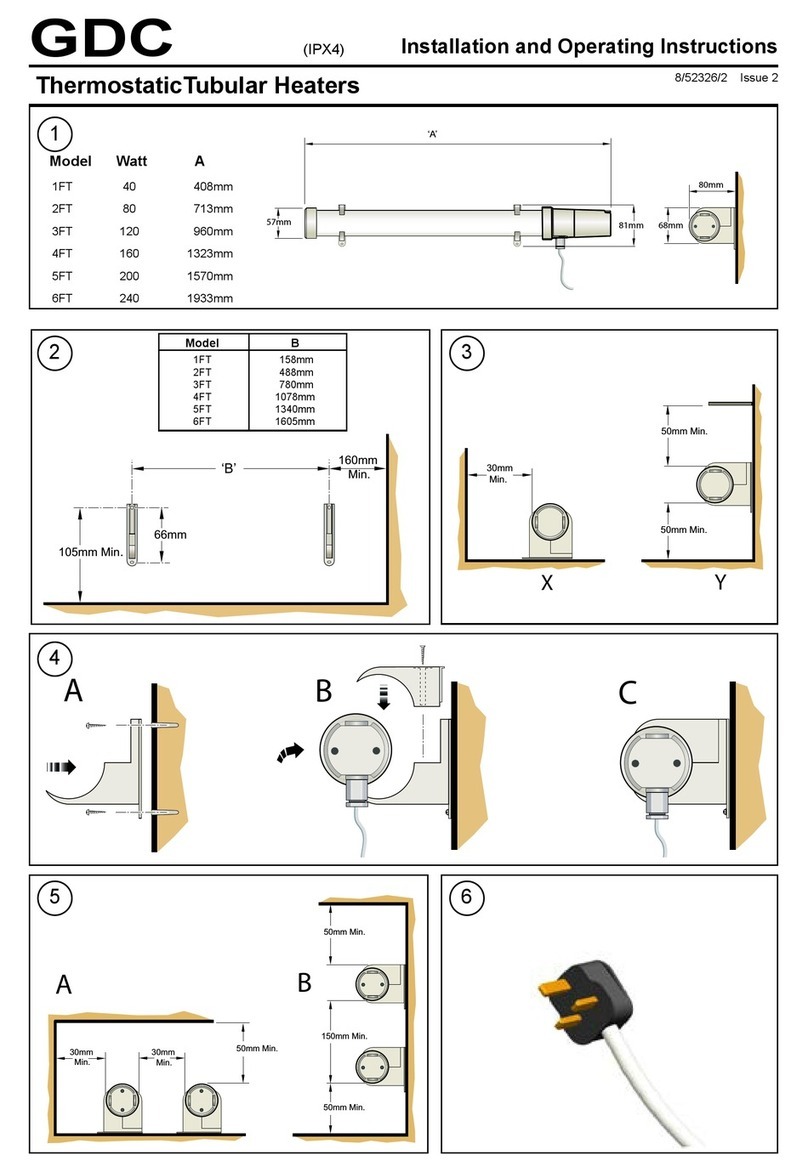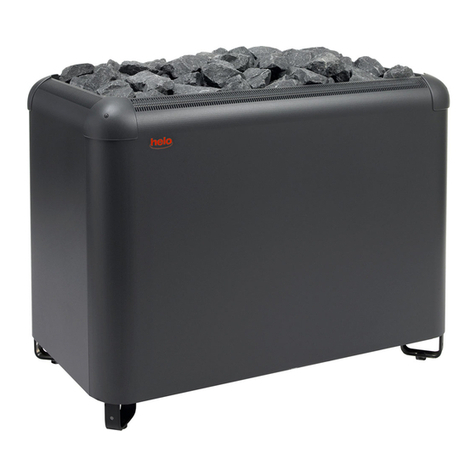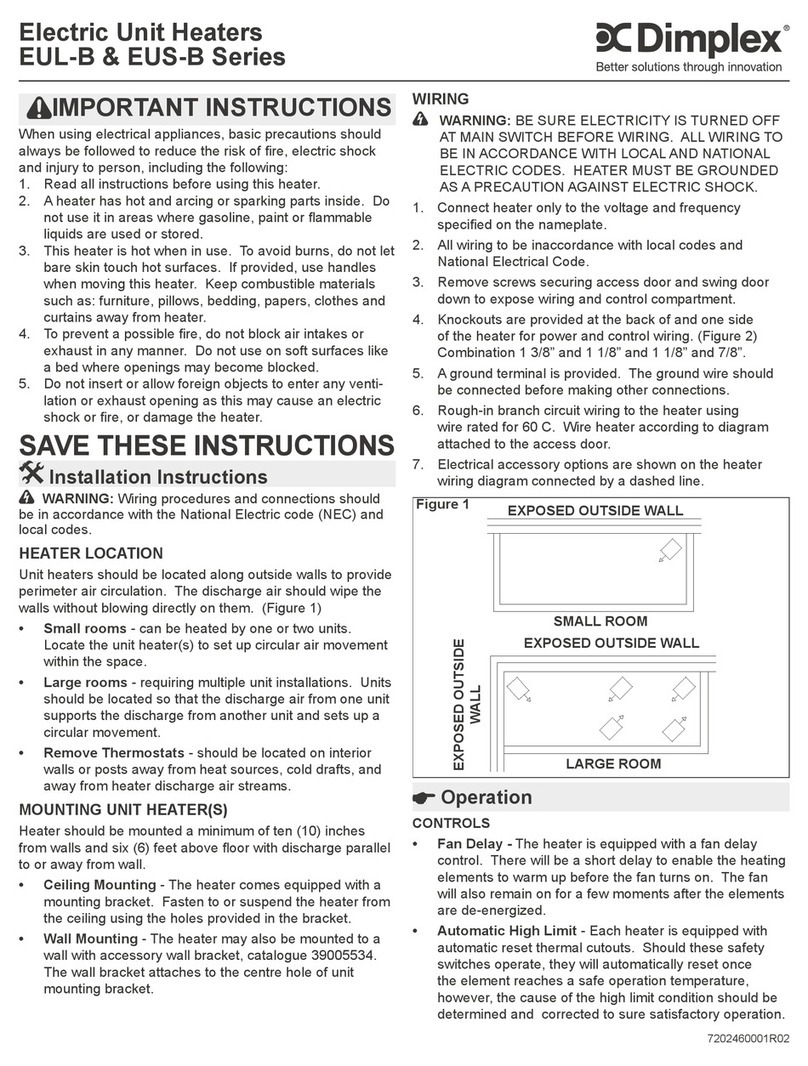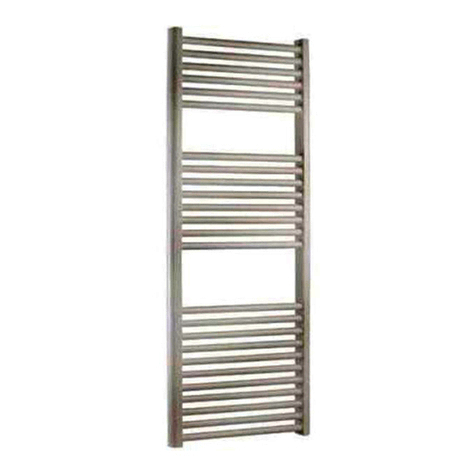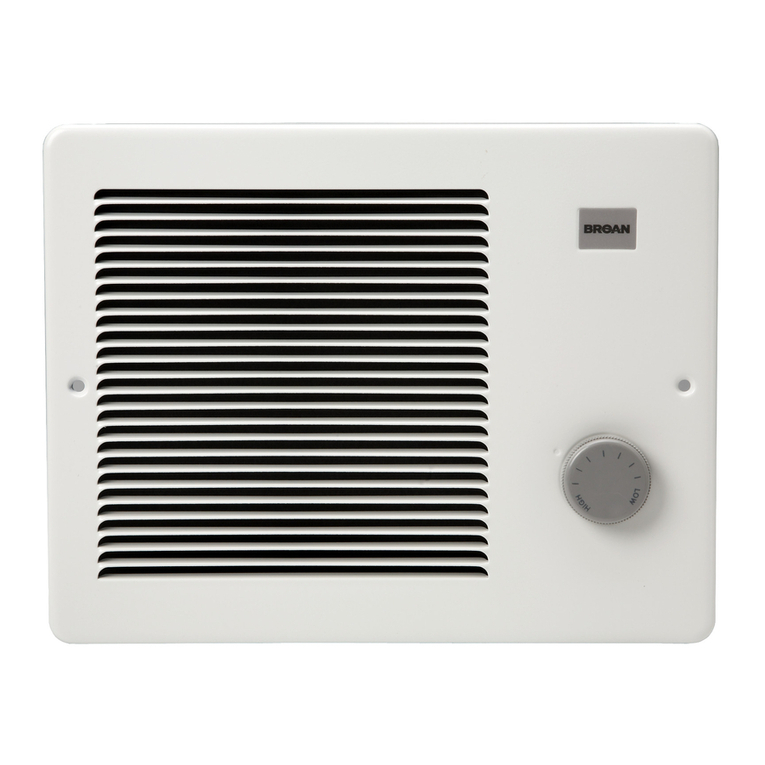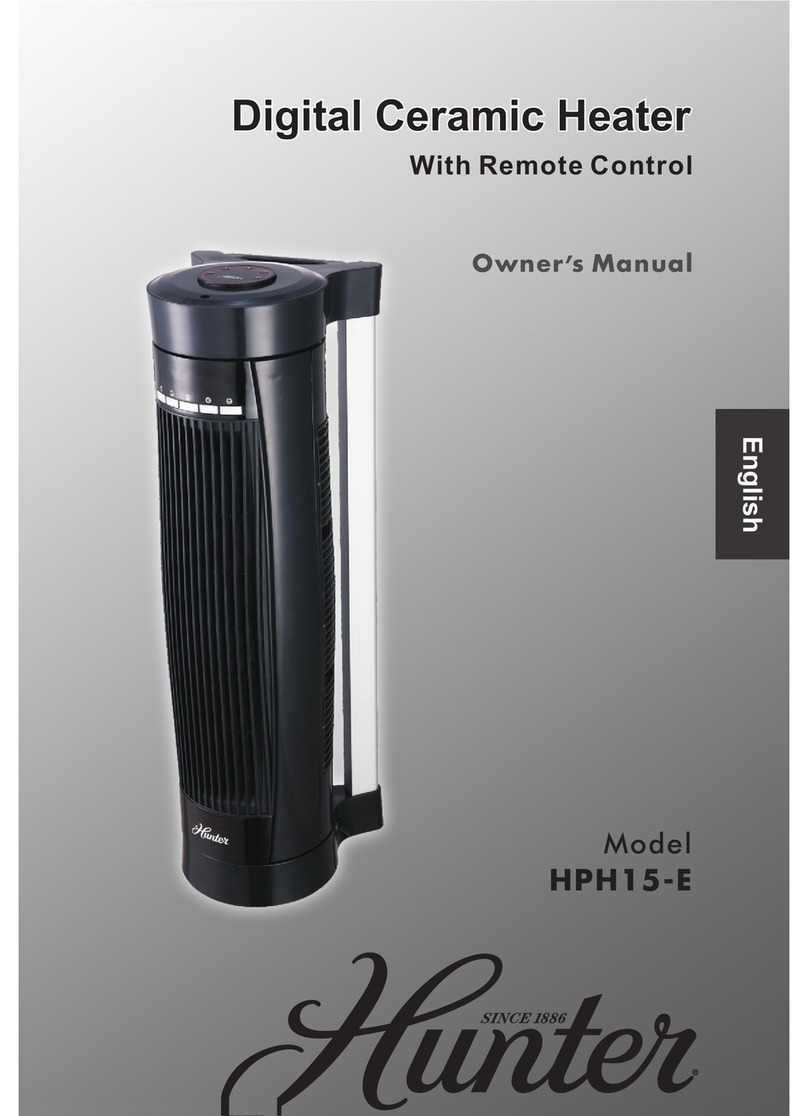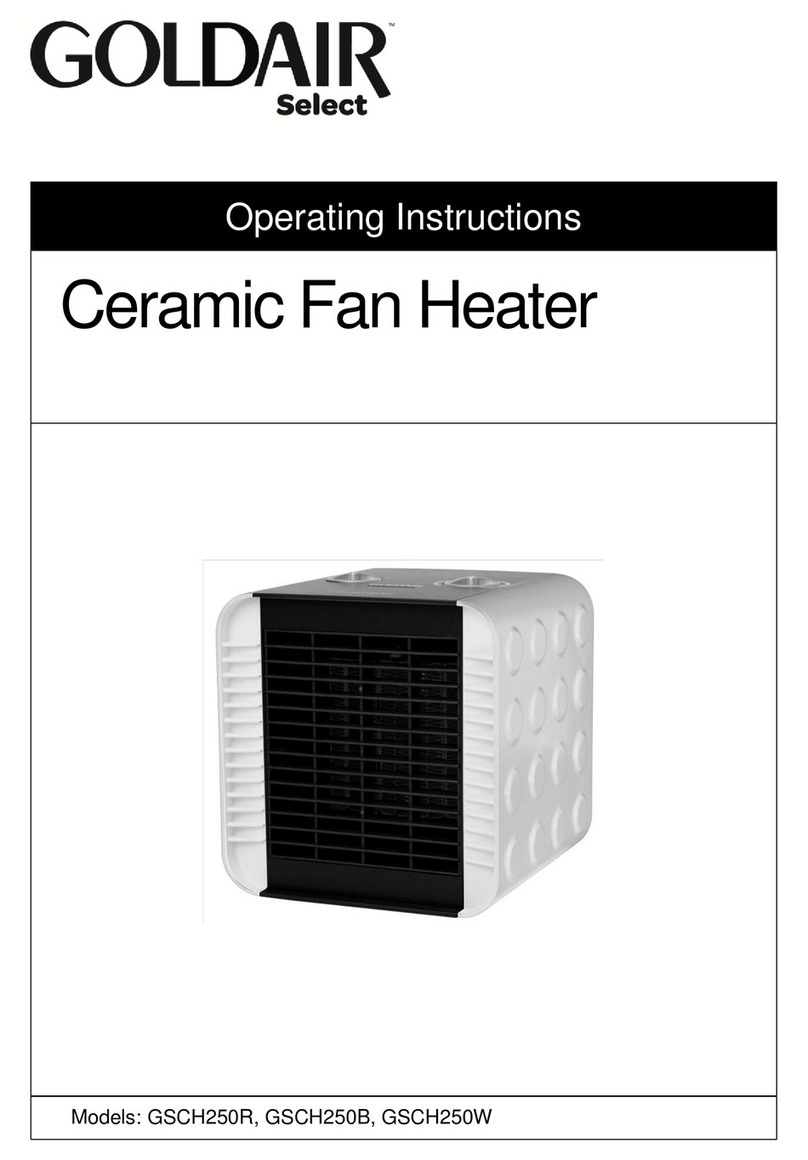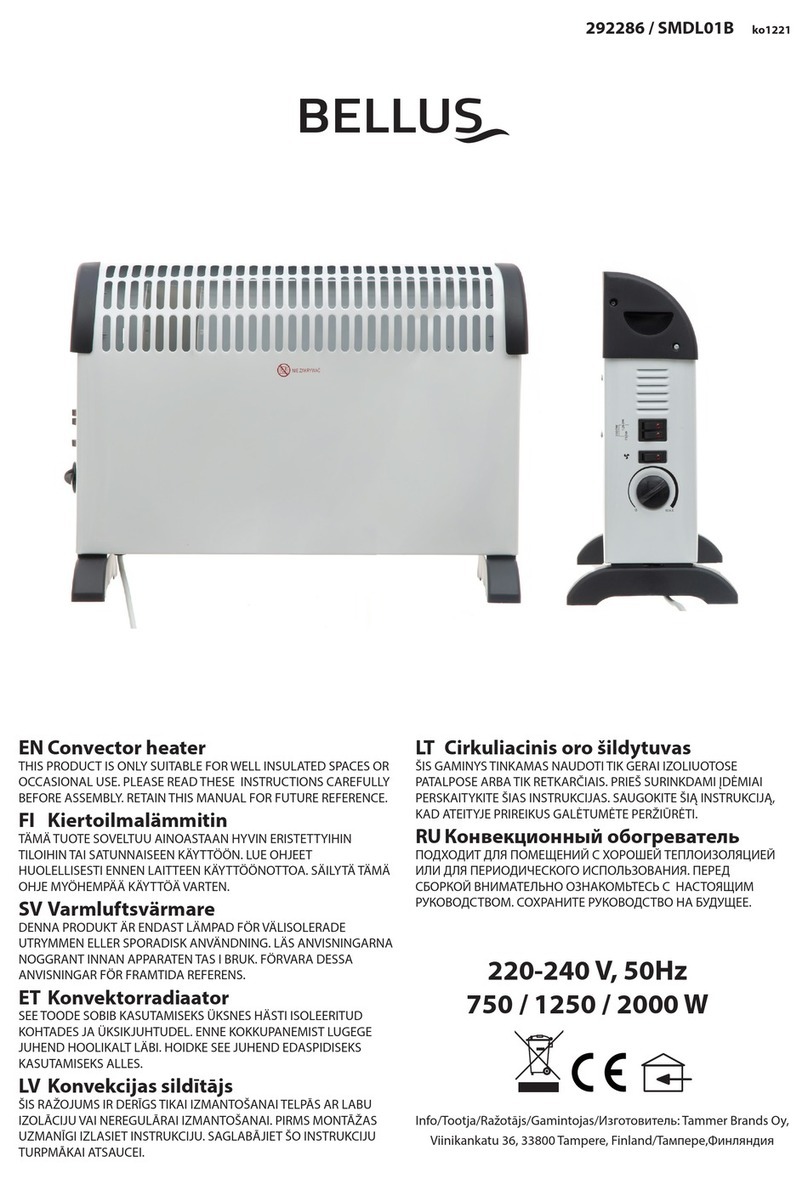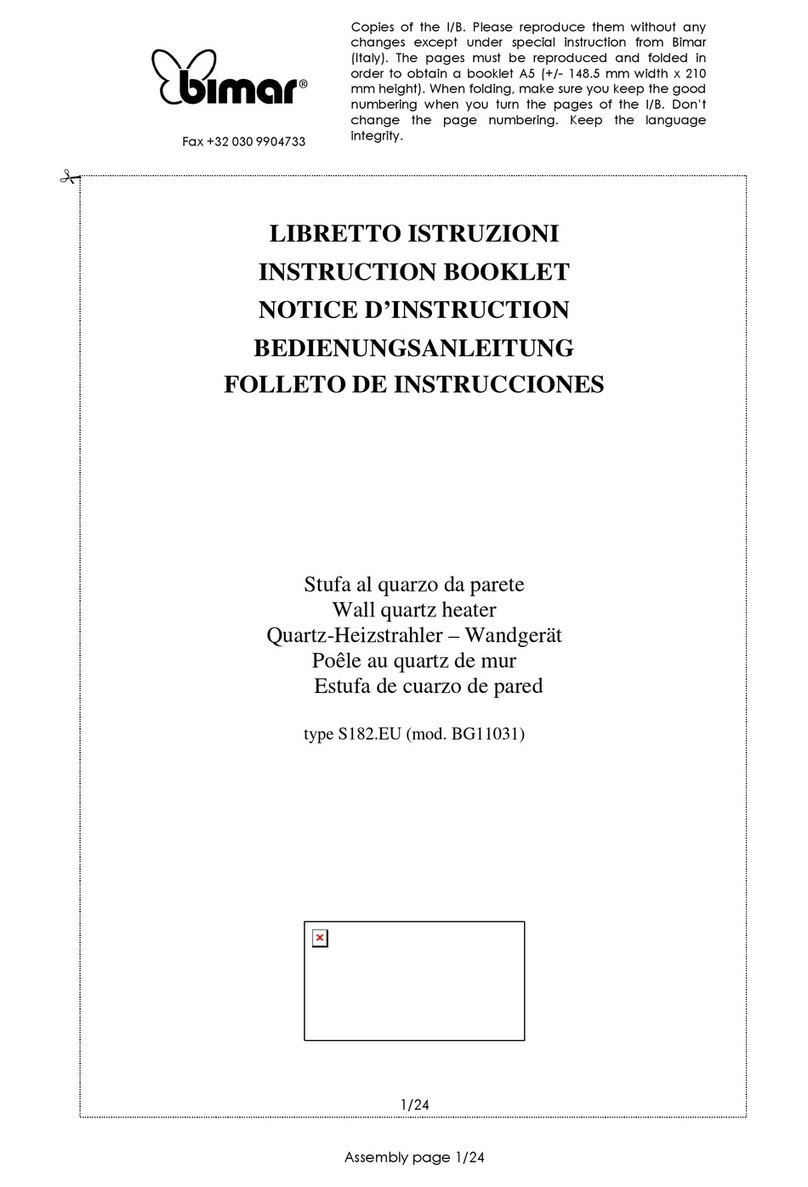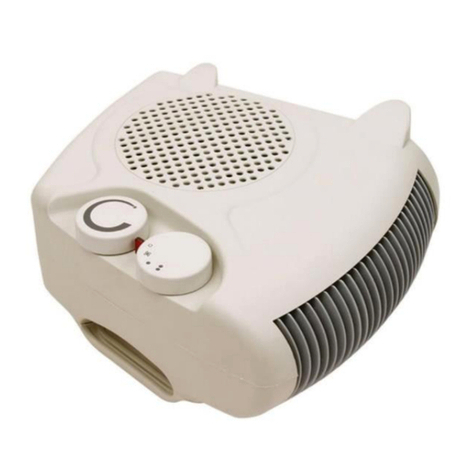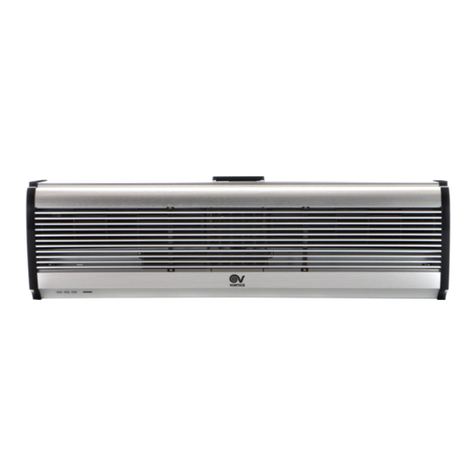GDC Comfortstat 2 F 8ST Installation instructions

Brazilia F 5, F 5S, F 8S &
Comfortstat 2 F 8ST
Balanced Flue Gas Wall Heaters
Installation and Owner Guide
Please leave these instructions with the user
5131922 / 05
Brazilia F 5 Brazilia F 5S
Brazilia F 8ST Comfortstat 2
Brazilia F 8S
© GDC Group Ltd. 2012

2
Natural Gas
Brazilia F 5
G.C.No. 35 075 01
Brazilia F 5S Mahogany
G.C.No. 35 075 02
Brazilia F 5S Oak
G.C.No. 35 075 02
Brazilia F 8S Mahogany
G.C.No. 35 075 03
Brazilia F 8S Oak
G.C.No. 35 075 03
Brazilia Comfortstat 2 F8ST Oak
G.C.No. 35 075 10
ropane
Brazilia F 5 ropane
G.C.No. 35 075 04
For GB/IE only.
© GDC Group Limited 2012.
All rights reserved. No part of this publication may be
reproduced in any material form (including photocopying),
stored in any medium by electronic means (including in
any retrieval system or database) or transmitted, in any
form or by any means, whether electronic, mechanical,
recording or otherwise, without the prior written permission
of the copyright owner.
Applications for the copyright owner's permission to
reproduce any part of this publication should be made,
giving details of the proposed use, to the following
address: GDC Group, Millbrook House, Grange Drive,
Hedge End, Southampton, SO30 2DF, U .
Warning: Any person who does any unauthorised act in
relation to a copyright work may be liable to criminal
prosecution and civil claims for damages.
Warning: Any person who does any unauthorised act in
relation to a copyright work may be liable to criminal
prosecution and civil claims for damages.
© GDC Group Ltd. 2012

Installer Guide
3
Installer guide 3 - 17
1.0 Introduction 4 - 5
2.0 Technical Data 6 - 7
3.0 Site Requirements 8 - 10
4.0 Installation 11
5.0 Commissioning the Appliance 12
6.0 Annual Servicing 13
7.0 Changing Components 14 - 17
8.0 Fault Finding 18
9.0 Short arts List 19
Owner guide 20- 27
1.0 Warnings 21
1.1 Safe Installation 21
1.2 In case of gas leaks 21
1.3 Guarding 21
1.4 Servicing your Appliance 21
2.0 Introduction & Operation 22
2.1 Introduction 22
2.2 Operating units that are not fitted
with the Comfortstat control 22
2.3 Operating units fitted with the
Comfortstat control 23
3.0 Cleaning & Clearances 24
3.1 Cleaning the Appliance 24
3.2 Clearances 24
4.0 Spares & Running costs 25
4.1 Spare Parts 25
4.2 Running Costs 25
5.0 Warranty & Service 26
6.0 Warning 28
Section Page(s)
Contents
Installer
Before continuing any further with the
installation of this appliance please read the
following guide to manual handling:
- The lifting weight of this appliance is as below:
Model Gross weight (kg)
F 5 18.0.
F 5S 19.1.
F 8S & F 8ST 24.4.
- One person should be sufficient to lift the fire. If
for any reason this weight is considered too
heavy then obtain assistance.
- When lifting always keep your back straight.
Bend your legs and not your back.
- Avoid twisting at the waist. It is better to
reposition your feet.
- Avoid upper body/top heavy bending. Do not
lean forward or sideways whilst handling the
fire.
- Always grip with the palm of the hand. Do not
use the tips of fingers for support.
- Always keep the fire as close to the body as
possible. This will minimise the cantilever
action.
- Use gloves to provide additional grip.
- Always use assistance if required.
© GDC Group Ltd. 2012

1.0 Introduction
4
1.1 Description
- The Brazilia F is a range of room sealed gas
convector appliances designed to be used with
gas type G20 (Natural Gas) at supply pressure 20
mbar. When converted using the below kits the
non thermostatic range is also suitable for use
with gas type G31 (Propane) at supply pressure
37 mbar.
L G Kits
F 5 & F 5S 5110284
F8S 5110285
The procedure for installation, servicing etc. is the
same for both Natural Gas and Propane models.
- The appliance provides warm air by natural
convection and flueing is by means of a concentric
balanced flue arrangement.
- Except for Comfortstat, the appliance is
controlled by a control knob which operates the
ignition and alters the heat output. The control
knob has five positions giving a choice of three
output rates:
- (Comfortstat only)
The appliance is controlled by an upper control
knob which operates the ignition and burner
setting.
A lower control knob alters the temperature
setting, the knob has seven positions.
osition
osition
osition
osition
OFF
LOW
IGNITION
MEDIUM
HIGH
l
ll
lll
Brazilia F 5
Brazilia F 5S
Brazilia F 8S
Fig. 1
Fig. 2
Brazilia F 8ST
Fig. 3
Fig. 4
IM ORTANT: The appliance must only be
used on its designated gas type. This is
indicated on the information label.
Installer Guide
osition
osition
osition
osition
OFF
IGNITION
LOW
HIGH
© GDC Group Ltd. 2012

5
Notice
Discolouration of wall surfaces
Most heating appliances generate warm air convection
currents and transfer heat to any wall surface against
which they are situated.
Some soft furnishings (such as blown vinyl wallpapers)
may not be suitable for use where they are subject to
temperatures above normal room levels and the
manufacturer's advice should be sought before using this
type of wall covering adjacent to any heating appliance.
The likelihood of wall staining from convected air currents
will be increased in environments where high levels of
tobacco smoke or other contaminants exist.
1.7 Important Information.
This product uses insulation board and gaskets
containing Refractory Ceramic Fibres (RCF), which are
man-made vitreous silicate fibres. Excessive exposure to
these materials may cause irritation to eyes, skin and -
respiratory tract. Consequently, it is important to take care
when handling these articles to ensure that the release of
dust is kept to a minimum. To ensure that the release of
fibres from these RCF articles is kept to a minimum,
during installation and servicing we recommend that you
use a HE A filtered vacuum to remove any dust and soot
accumulated in and around the fire before and after
working on the fire. When replacing these articles we
recommend that the replaced items are not broken up, but
are sealed within a heavy duty polythene bag, clearly
labelled as RCF waste. RCF waste is classed as a stable,
non-reactive hazardous waste and may be disposed at a
landfill licenced to accept such waste. rotective clothing
is not required when handling these articles, but we
recommend the use of suitable gloves to prevent irritation.
We also recommend you follow the normal hygiene rules
of not smoking, eating or drinking in the work area and
always wash your hands before eating or drinking.
This appliance does not contain any component
manufactured from asbestos or asbestos related products.
Installer Guide
1.0 Introduction
© GDC Group Ltd. 2012
The installation must be in accordance with this guide.
For the user’s protection, in the United ingdom it is the law that all gas
appliances are installed by competent persons in accordance with the
current edition of the Gas Safety (Installation and Use) Regulations.
Failure to install the appliance correctly could lead to prosecution. GAS
SAFE REGISTER and CORGI require their members to work to
recognised standards.
In the United ingdom the installation must also be in accordance with:
All the relevant parts of local regulations.
The relevant parts of the current editions of the following British
Standards:-
BS 5440 Part 1- Installation of flues
BS 5871 Part 1- Installation - Gas fires
BS 6891- Installation of low pressure gas pipework
of up to 35mm (R1 ¼) in domestic
premises (2nd family gas) - specification.
-In England and Wales, the current edition of the Building Regulations
issued by the Department of the Environment and the Welsh Office.
-In Scotland, the current edition of the Building Standards (Scotland)
Regulations issued by the Scottish Executive.
-In Northern Ireland, the current edition of the Building regulations
(Northern Ireland) issued by the Department of the Environment for
Northern Ireland.
-In the republic of Ireland the installation must be carried out by a
competent person and also conform to the relevant parts of:
a) The current edition of IS 813 “Domestic Gas Installations”
b) All relevant national and local rules in force.
Where no specific instructions are given, reference should be made to the
relevant British Standard Code of Practice.
1.3 Considerations for timber framed buildings.
Installation to a timber-framed building should be in accordance with the
relevant sections of The Institute of Gas Engineers publication IGE/UP/7
“Gas installations in timber frame buildings”.
Please note that advice should be sought before installing in a timber
frame building since the alterations required may nullify any NHBC cover
relating to the property. If in doubt, guidance should be requested from
your local authority planning or building department.
Under no circumstances is the fire to be recessed into timber frame
constructions.
1.4 Ventilation requirements.
No special ventilation bricks or vents are required into the room containing
the appliance.
1.5 Fireguard requirements.
A fireguard complying with BS 8423 should be fitted for the protection of
young children, the elderly, the infirm and pet animals.
1.6 Room considerations.
It is advisable that combustible fabrics such as curtains are not fitted above
the fire. If, however, this is unavoidable, the extreme bottom edge of the
fabric must be at least 780mm above the base of the fire.
1.2 Regulations, Standards and Law.

6
F 8S & F 8ST Natural Gas
Category of Appliance F 8S II2H3P
Category of Appliance F 8ST I2H
The appliance is set for Gas Type G20 at 20mbar.
Heat Input (gross) High Med Low Low
kW 3.06 2.21 1.50 1.27
Btu/h 10,440 7,540 5,118 4,333
Heat Output (gross) High Med Low Low
kW 2.26 1.48 0.6 0.80
Btu/h 7,700 5,050 2,047 2,730
Setting ressure Cold
F Range mbar 19.25 ± 0.75
in wg 7.7 ± 0.3
Setting ressure Cold
Comfortstat mbar 20.00 ± 1.00
in wg 8.0 ± 0.4
Injector Size CO1
Nox Class 2
Gas Rate
on HIGH 0.29 m3/h (10.28 ft3/h)
Gas Connection
F 8S - R 1/4(1/4BSP external)
F 8ST - 8mm nut and olive
Ignition Piezo Spark
acked Weight F 8S & F 8ST
24.4 kg (54 lbs)
Dimensions F 8S F 8ST
Height 430mm 430mm
Width 516mm 516mm
Depth 152mm 170mm
(from the wall)
Controls Rotary gas tap allowing
Non Thermostat manual adjustment
between low, medium
and high output.
Flame failure device.
Controls Rotary thermostat allowing
Comfortstat a lowt position and
adjustment between low and
high temperature settings.
Flame failure device.
Thermocouple
Output 8-13mv
Heat Exchanger Cast Iron
2.0 Technical Data
F 5 & F 5S Natural Gas
Category of Appliance II2H3P
The appliance is set for Gas Type G20 at 20mbar.
Heat Input (gross) High Med Low
kW 2.05 1.41 0.86
Btu/h 7,000 4,800 3,000
Heat Output (gross) High Med Low
kW 1.5 0.98 0.57
Btu/h 5,100 3,350 1,950
Setting ressure Cold
mbar 19.7 ± 0.75
in wg 7.9 ± 0.3
Injector Size CO2
Nox Class 3
Gas Rate
on HIGH 0.195 m3/h (6.89 ft3/h)
Gas Connection R 1/4(1/4BSP external)
Ignition Piezo Spark
acked Weight F 5 F 5S
18 kg 18.4 kg
(39.7 lbs) (40.6 lbs)
Dimensions F 5 F 5S
Height 394mm 394mm
Width 426mm 450mm
Depth 126mm 128mm
(from the wall)
Controls Rotary gas tap allowing
manual adjustment
between low, medium
and high output.
Flame failure device.
Thermocouple
Output 8-13mv
Heat Exchanger Cast Iron
Except
Comfort
Stat
Comfort
Stat
Except
Comfort
Stat
Comfort
Stat
Installer Guide
Except
Comfort
Stat
Except
Comfort
Stat
© GDC Group Ltd. 2012

F 8S ropane
(When converted using kit No. 5110285)
Category of Appliance II2H3P
The appliance is set for Gas Type G31 at 37mbar.
Heat Input (gross) High Med Low
kW 3.06 2.21 1.27
Btu/h 10,440 7,540 4,333
Heat Output (gross) High Med Low
kW 2.26 1.48 0.80
Btu/h 7,700 5,050 2,730
Setting ressure Cold
mbar 36.5 ± 1
in wg 14.6 ± 0.4
Injector Size 90
Nox Class 2
Gas Rate
on HIGH 0.115 m3/h (0.218 kg/h)
Gas Connection R 1/4(1/4BSP external)
Ignition Piezo Spark
acked Weight F 8S
24.4 kg
(54 lbs)
Dimensions F 8S
Height 430mm
Width 516mm
Depth 152mm
(from the wall)
Controls Rotary gas tap allowing
manual adjustment
between low, medium
and high output.
Flame failure device.
Thermocouple
Output 8-13mv
Heat Exchanger Cast Iron
2.0 Technical Data
F 5 & F 5S ropane
(When converted using kit No. 5110284)
Category of Appliance II2H3P
The appliance is set for Gas Type G31 at 37mbar.
Heat Input (gross) High Med Low
kW 2.05 1.41 0.86
Btu/h 7,000 4,800 3,000
Heat Output (gross) High Med Low
kW 1.5 0.98 0.57
Btu/h 5,100 3,350 1,950
Setting ressure Cold
mbar 36.5 ± 1
in wg 14.6 ± 0.4
Injector Size 74
Nox Class 3
Gas Rate
on HIGH 0.077 m3/h (0.146 kg/h)
Gas Connection R 1/4(1/4BSP external)
Ignition Piezo Spark
acked Weight F 5 F 5S
18 kg 18.4 kg
(39.7 lbs) (40.6 lbs)
Dimensions F 5 F 5S
Height 394mm 394mm
Width 426mm 450mm
Depth 126mm 128mm
(from the wall)
Controls Rotary gas tap allowing
manual adjustment
between low, medium
and high output.
Flame failure device.
Thermocouple
Output 8-13mv
Heat Exchanger Cast Iron
Installer Guide
7
© GDC Group Ltd. 2012

8
3.0 Site Requirements
3.1 Location
1. The appliance must be fitted on a suitable
outside wall to meet the requirements of the
balanced flue arrangement.
2. For applications involving walls constructed
from or comprising of combustible material,
reference should be made to the requirements of
B.S. 5871 and Building Regulations.
3. Building Regulations will require the flue duct to
be separated from any combustible material
within the wall by a non-combustible sleeve
enclosing an annular air space of at least 25mm
(1 in) around the flue duct.
4. If the outer face of the wall is combustible, a
plate of metal (or other non-combustible material)
should be fitted over the flue duct extending at
least 50mm (2 in) around the terminal.
5. Further guidance on timber frame construction
is given in the Institute of Gas Engineers UP7.
“Guide for Gas Installations in Timber Framed
Dwellings”.
3.2 Clearances
1. The appliance must be fitted on a vertical flat
non-combustible wall. Any combustible wall
coverings should be removed from within the area
of the outer case.
2. Internally the appliance must not be fitted under
a shelf or sill which has a projection of more than
150mm (6 in).
3. Curtains or a shelf must not be closer than
140mm (51/2in) (F 5 & F 5S), 89mm (31/2in) (F 8S
& F 8ST) from top of outer case.
4. The bottom of the outer case must be a
minimum of 72mm (27/8in) from the floor. Subject
to this minimum dimension it is recommended
that the appliance is fitted as close to the floor as
possible for optimum distribution of heat.
5. Minimum side clearance form any wall or fixed
furniture to the outer case is:
Left hand side: 45mm (13/4in)
Right hand side: 57mm (21/4in)
Installer Guide
IM ORTANT: LPG Models.
This appliance must not be installed below
ground in basements, cellars, etc. unless
these are open to ground level on one side.
For further guidance see
BS 5871 Pt.1.
© GDC Group Ltd. 2012

Terminal Position with Minimum Distance (mm)
A* Directly below an openable window or other opening, e.g. an air brick. 300
B* Below gutters. 300
C* Below eaves, soil pipes or drain pipes. 300
D Below balconies or car port roof 600
E From vertical drain pipes and soil pipes. 300
F From internal or external corners. 600
G Above ground, roof or balcony level. 300
H From a surface facing a terminal. 600
I From a terminal facing a terminal. 600
J Vertically from a terminal on the same wall. 1500
Horizontally from a terminal on the same wall. 300
L For an opening in a car port (e.g. door, window) into a dwelling. 1200
*In addition, the terminal should not be nearer than 300mm to an opening in the
building fabric formed for the purpose of accommodating a built-in element such
as a window frame or door frame (Fig. 8).
Fig. 5
Fig. 7 (side view). Angle of drop
shown exaggerated.
Fig. 8
3.3 Flue osition
1. The siting of the balanced flue terminal must
meet the following conditions:
a. Where the flue terminal of the appliance is
beneath any opening (that is to say, any part of a
window capable of being opened, or any
ventilation inlet or similar opening) no part of the
terminal shall be within 300mm (1 ft), measured
vertically from the bottom of the opening.
b. Where the flue terminal of the appliance is
less than 2m (6 ft) above the level of any ground,
balcony, flat roof or place to which any person
has access and which adjoins the wall in which
the flue terminal is situated, the terminal shall be
protected by a guard.
c. The guard must be screwed to the wall over
the flue terminal and be at least 50mm (2 in)
clear of any part of the terminal. A suitable guard
is available direct from the GDC Group service
dept., Part No. 080266 (Fig. 6).
d. Not within 300mm (1 ft) of ground level.
2. Fig. 4 shows the positioning of the flue
terminal relative to buildings and other
structures.
3. If the outer face of the outside wall is of
combustible material (timber, etc.) a metal or
other non-combustible material plate should be
fitted round the flue terminal so that it extends
not less than 50mm (2 in) around the terminal. A
179mm (7 in) square or a 230mm (9 in) diameter
circular plate will meet the requirement.
4. The flue should run horizontally, or with a
slight drop to the terminal, in order to prevent
rain entry (Fig. 7).
3.0 Site Requirements
Fig. 6
Installer Guide
9
© GDC Group Ltd. 2012

10
3.0 Site Requirements
381mm-483mm
(15in - 19in)
520mm-610mm
(201/2in - 24in)
Flue Option
Wall Thickness
Part No
243857
Part No
243848
3.4 Flue Dimensions
1. The standard appliance is supplied with flue
ducting which is adjustable to accommodate wall
thicknesses from 248mm (93/4in) to 349mm
(133/4in).
2. Two further flue terminals are available as
optional extras to suit the wall thicknesses
indicated in the table opposite.
3.5 Ventilation
1. The appliance is room sealed and therefore
requires no purpose built ventilation.
2. It is intended for use in habitable rooms, and
must not be fitted in cupboards or confined
compartments.
3.6 Gas Supply
1. The inlet connection is located on the gas tap
at the bottom right hand side of the appliance.
Comfortstat models have an 8mm nut and olive
connection. All other models use R1/4(1/4BSP
external).
2. A gas service cock must be fitted in the supply
to the appliance with a disconnecting union
between the service cock and the inlet
connection.
NOTE: If the gas supply is run either to the
left or right on leaving the appliance, at least
the first 51mm (2 in) from the inlet connection
must run vertically downwards to avoid the
outer case fouling the gas supply.
Installer Guide
© GDC Group Ltd. 2012
F8S & F8ST F5 & F5S
Not
available
Not
available

4.0 Installation
4.1 reparation
1. Ensure that the length of the flue ducting is
suitable for the wall thickness.
2. Select a position for the appliance. Using the
template supplied, mark the position of the flue
ducting and the four fixing holes. Ensure that the
template is vertical (Fig. 9 or 10 depending on
model).
3. Cut a neat hole 127 - 140mm (5 - 51/2in) in the
wall for the flue.
4. Drill and plug the wall at the four fixing holes
using a 6mm (1/4in) drill.
4.2 Fitting the Appliance
1. Slide the flue duct and terminal assembly into
the flue outlet at the rear of the appliance.
Ensure that the flue duct spotwelds are not at the
bottom.
2. To determine the flue length, measure the wall
thickness and add 20mm (3/4in). Adjust the
distance from the back of the airbox and the joint
between the terminal and air duct to this
dimension. Using the length of flue tape provided
fix this dimension by taping up the joint between
the flue duct assembly and the flue outlet.
3. Offer the appliance up to the wall pushing the
terminal and flue ducting through the wall.
4. Ensuring that the appliance is level, secure it
to the wall using four suitable screws and
washers. Check that the wall sealing ring is
correctly positioned and seals against the wall
(Fig. 11).
5. Ensure that the flue terminal protrudes
sufficiently on the outside wall face (Fig. 11).
Make good as appropriate.
6. Connect the gas supply incorporating a gas
service cock and a disconnecting union between
the service cock and the inlet connection.
7. Check for gas soundness (B.S. 6891).
Fig. 9 (F 8S & F 8ST)
Fig. 10 (F 5 & F 5S)
Fig. 11 (Top View)
8
5
Installer Guide
11
© GDC Group Ltd. 2012

12
5.0 Commissioning the Appliance
5.1 Commissioning the Appliance
1. Turn on the gas service cock.
2. Where applicable, fit the control knob onto the
control tap spindle (Fig. 12).
3. Purge any air from the system.
4. Non Comfortstat models - Remove the
pressure test point screw.
Comfortstat models - Loosen the pressure test
point screw.
Fit a pressure gauge to the pressure test point
(Fig. 12).
5. Push the control knob in and turn
anticlockwise to the ignition ( ) / ( ) position.
The main burner should light. eep the control
knob pushed in for 20 seconds. If the burner fails
to remain alight repeat the procedure. Check that
the gas supply is correct by measuring the
pressure at the test point on the gas control tap.
6. No adjustment is provided on the appliance. If
it is found that the test pressure is not within the
tolerances given, consult the gas supplier.
7. Push in and turn the control knob back to the
OFF ( ) position. Remove pressure gauge and
replace the pressure test point screw.
8. Relight the appliance and check for gas
soundness.
5.2 Fitting the Outer Case
Before fitting the case it is important that the
details on the last page of this guide are
completed.
1. Push in and turn the control knob back to the
OFF ( ) position.
2. On models not fitted with the Comfortstat
control, remove the knob from the appliance by
gently pulling the knob forward (Fig. 12).
3. Fit the outer case by locating the slots in the
outer case rear strip onto the four mounting lugs
on the wall brackets (Fig. 14).
4. Where applicable, replace the control knob
(Fig. 14).
5.3 Instructing the User
1. Explain how to ignite the appliance and alter
the heat settings.
2. Show the position of the external gas service
cock.
3. Instruct the user that the bottom and top of the
case must never be obstructed in any way and
emphasise that clothes etc must never be hung
over the appliance to dry as this will cause
overheating and possible damage.
4. Hand over this guide and recommend that for
reasons of safety and economy the appliance
should be serviced annually by a competent
person.
L. .G. Setting ressure (Cold/High Rate)
F5 & F5S F8S
36.5 ± 1mbar 36.5 ± 1mbar
(14.6 ± 0.4in wg) (14.6 ± 0.4in wg)
N.G. Setting ressure (Cold/High Rate)
F5 & F5S F8S
19.7 ± 0.75mbar 19.25 ± 0.75mbar
(7.9 ± 0.3in wg) (7.7 ± 0.3in wg)
F8ST Comfortstat 2
20.00 ± 1.0mbar
(8.0 ± 0.4in wg)
Control nob
Pressure Test Point
Viewing Window
Mounting Lugs
Fig. 12
Fig. 13
Fig. 14
Igniter removed
for clarity
Installer Guide
Comfortstat models only
Pressure Test Point
at front marked
© GDC Group Ltd. 2012

6.0 Annual Servicing
6.1 Servicing the Appliance
1. For reasons of safety and economy the appliance
should be serviced annually.
2. Before servicing please read Section 1.3 Important
Information.
3. Turn off the gas supply and ensure that the appliance
is cold.
4. On models not fitted with the Comfortstat control,
remove the control knob by pulling forward.
5. Remove the case by easing upward and forward until
it is clear of its retaining lugs.
6. Undo the heat exchanger retaining nuts and washers
(Fig. 16) and draw the casting forward off the locating
studs.
7. Remove the three screws holding the burner
retaining plate to the airbox and undo the thermocouple
nut from the gas tap (Fig. 17 & 20).
8. Ease the thermocouple and electrode lead from the
rubber grommet (Fig. 18).
9. Disengage the burner from the injector and pull the
electrode lead off the spark electrode (Fig. 17).
10. Check that the insulation is undamaged. Replace if
necessary. (Fig. 19).
11. Remove and clean the injector and sealing washer.
The injector must not be cleaned with a needle or wire
(Fig. 20). If the sealing washer is damaged it must be
replaced.
12. Check that the flue outlet tube is clear (Fig. 19).
13. Brush away any dirt from the heat exchanger
casting. If necessary clean the viewing window.
14. With a light brush carefully remove deposits from
the spark electrode, burner flame ports and the burner
gauze (Fig. 17).
15. Replace the rope seal in the heat exchanger casting
if it is damaged in any way (Fig. 16). Also examine the
thermocouple and replace if necessary.
16. Re-assemble the injector, washer and burner
assembly in reverse order of dismantling. Ensure that
the spark gap is correct ie. 3.5mm ± 0.5mm. Check that
the burner is horizontal and correctly positioned on the
injector with the gauze covering the primary aeration
hole.
17. Check the gas pressure at the test point on the gas
control tap. If the pressure is not within the tolerance,
(see Section 2.0 Technical Data) the gas supply to the
unit needs to be investigated.
18. Check that the burner ignition is satisfactory. Ensure
that the thermocouple/electrode lead grommet is
correctly positioned and re-fit the heat exchanger
casting.
19. Check for gas soundness.
20. Fit the case and control knob (where applicable)
and re-check that the ignition is satisfactory.
Burner Retaining Plate
Injector
Thermocouple nut
Gas Tap
Electrode Lead
Washer
Grommet
Electrode Lead
Thermocouple wires
Burner Flame Ports
Spark
Electrode
Burner Gauze
Flue Outlet Tube
Insulation
Heat Exchanger Casting
Rope Seal
Outer Case
Control nob
Fig. 15
Fig. 16
Fig. 17
Fig. 18
Fig. 19
Fig. 20
Installer Guide
13
© GDC Group Ltd. 2012

14
7.0 Changing components on
models without the Comfortstat
control
7.1 Changing Components
1. Before changing any components please read
Section 1.3 Important Information.
2. Turn off the gas supply and ensure that the
appliance is cold.
3. Remove the control knob by pulling forward,
then remove the case by easing upwards and
forwards until it is clear of its retaining lugs (Fig.
21).
4. After changing any components
re-commission the appliance
7.2 iezo Unit (Fig. 22).
1. Pull off the spark lead at the rear of the igniter.
2. Straighten the tabs securing the piezo unit to
the tap retaining plate and remove.
3. Fit the new piezo unit and twist the tabs
slightly to secure.
4. Replace all components in the reverse order of
dismantling.
7.3 Gas Control Tap
1. Undo the heat exchanger retaining nuts and
washers and draw the casting forwards off the
locating studs.
2. Remove the three screws holding the burner
retaining plate to the airbox and undo the
thermocouple nut from the gas tap (Fig. 23 & 25).
3. Ease the thermocouple and electrode leads
from the rubber grommet (Fig. 24).
4. Disengage the burner from the injector and
pull the electrode lead off the spark electrode
(Fig. 23).
5. Pull off the spark electrode lead at the rear of
the igniter (Fig. 25).
6. Remove the supply pipe from the gas tap.
7. Undo the nut holding the gas tap to its
retaining bracket, and disengage the tap from the
bracket (Fig. 25).
8. Remove the injector and sealing washer. If the
washer is damaged it must be replaced.
9. On re-assembly ensure that the airbox sealing
grommet is correctly positioned and check for
gas soundness.
Mounting Lugs
Igniter
Tabs
Electrode
Lead
Burner Retaining Plate
Injector
Thermocouple wires
Gas Tap Locating
Bracket
Gas Tap
Electrode Lead
Washer
Grommet
Electrode Lead
Thermocouple wires
Burner Flame Ports
Spark
Electrode
Burner Gauze
Flue Outlet Tube
Insulation
Fig. 21
Fig. 22
Fig. 23
Fig. 24
Fig. 25
Installer Guide
© GDC Group Ltd. 2012

7.4 Burner
1. Undo the heat exchanger retaining nuts and
washers and draw the casting forwards off the
locating studs (Fig. 26).
2. Remove the three screws holding the burner
retaining plate to the airbox, also remove the
insulation and undo the thermocouple nut from
the gas tap (Fig. 27 & 29).
3. Ease the thermocouple and electrode lead
from the rubber grommet (Fig. 28).
4. Disengage the burner from the injector and
pull the electrode lead off the spark electrode
(Fig. 27).
5. Remove the intake gauze from the burner inlet
and undo the screws securing the burner to its’
retaining plate, noting the position of the shield at
the left hand side (Fig. 27).
6. Undo the screw securing the spark electrode
to the burner. Fit the electrode to the new burner
(Fig. 27).
7. Fit the intake gauze to the burner inlet
ensuring that it covers the primary aeration hole
(Fig. 27).
8. Reassemble in reverse order of dismantling.
7.5 Injector
1. Remove the burner as described in sections
7.4.1 to 7.4.4 .
2. Undo the injector and sealing washer,
retaining the washer for use with the new
injector. If the washer is damaged it must be
replaced (Fig. 29).
3. Reassemble in reverse order of dismantling.
7.6 Thermocouple
1. Remove the burner as described in sections
7.4.1 to 7.4.4 .
2. Undo the nut retaining the thermocouple tip to
the burner bracket and withdraw the
thermocouple (Fig. 27).
3. Bend the new thermocouple in a similar
manner to the one removed. Avoid any sharp
bends.
4. On reassembly ensure that the airbox sealing
grommet is correctly positioned.
Burner Retaining Plate
Injector
Thermocouple nut
Gas Tap
Electrode Lead
Washer
Grommet
Electrode Lead
Thermocouple wires
Spark Electrode
Burner Gauze
Shield
Thermocouple
Electrode Lead
Heat Exchanger Casting
Rope Seal
Fig. 26
Fig. 27
Fig. 28
Fig. 29
Installer Guide
15
7.0 Changing components on
models without the Comfortstat
control
© GDC Group Ltd. 2012

16
8.0 Changing components on
models with the Comfortstat
control
8.1 Changing Components
1. Before changing any components please read
Section 1.3 Important Information.
2. Turn off the gas supply and ensure that the
appliance is cold.
3. Remove the case by easing upward and
forward until it is clear of its retaining lugs (Fig.
30).
4. After changing any components
re-commission the appliance
8.2 Gas Control Tap
1. Undo the heat exchanger retaining nuts and
washers and draw the casting forward off the
locating studs. Once clear of the studs the
casting will need to be moved to the left to avoid
the gas tap locating bracket.
2. Remove the three screws holding the burner
retaining plate to the airbox, also remove the
insulation and undo the thermocouple nut from
the gas tap (Fig. 31 & 33).
3. Ease the thermocouple and electrode leads
from the rubber grommet (Fig. 32).
4. Disengage the burner from the injector and
pull the electrode lead off the spark electrode
5. Remove the supply pipe clamp and supply
pipe from the gas tap.
6. Unscrew and remove the pipe that connects
the gas tap to the injector carrier.
7. Unclip the thermostat phial.
8. Unscrew and remove the two screws that
secure the gas tap to the gas tap locating bracket
then ease the gas tap forward and clear of the
bracket.
9. On re-assembly ensure that the airbox sealing
grommet is correctly positioned and check for
gas soundness.
Mounting Lugs
Burner Retaining Plate
Grommet
Electrode Lead
Thermocouple
Burner Flame Ports
Spark
Electrode
Burner Gauze
Flue Outlet Tube
Insulation
Fig. 30
Fig. 31
Fig. 32
Installer Guide
Gas Tap
Injector
Washer
Fig. 33
Gas Tap Locating
Bracket Injector carrier
Seal
Lock nut
© GDC Group Ltd. 2012

17
8.3 Burner
1. Undo the heat exchanger retaining nuts and
washers and draw the casting forward off the
locating studs. Once clear of the studs the
casting will need to be moved to the left to avoid
the gas tap locating bracket. (Fig. 34).
2. Remove the three screws holding the burner
retaining plate to the airbox, also remove the
insulation and undo the thermocouple nut from
the gas tap (Fig. 35 & 37).
3. Ease the thermocouple and electrode lead
from the rubber grommet (Fig. 36).
4. Disengage the burner from the injector and
pull the electrode lead off the spark electrode
(Fig. 35).
5. Remove the intake gauze from the burner inlet
and undo the screws securing the burner to its’
retaining plate, noting the position of the shield at
the left hand side (Fig. 35).
6. Undo the screw securing the spark electrode
to the burner. Fit the electrode to the new burner
(Fig. 35).
7. Fit the intake gauze to the burner inlet
ensuring that it covers the primary aeration hole
(Fig. 35).
8. Reassemble in reverse order of dismantling.
8.4 Injector
1. Remove the burner as described in sections
8.3.1 to 8.3.4.
2. Undo the injector and sealing washer,
retaining the washer for use with the new
injector. If the washer is damaged it must be
replaced (Fig. 37).
3. Reassemble in reverse order of dismantling.
8.5 Thermocouple
1. Remove the burner as described in sections
8.3.1 to 8.3.4.
2. Undo the nut retaining the thermocouple tip to
the burner bracket and withdraw the
thermocouple.
3. Bend the new thermocouple in a similar
manner to the one removed. Avoid any sharp
bends.
4. On reassembly ensure that the airbox sealing
grommet is correctly positioned.
Burner Retaining Plate
Grommet
Electrode Lead Thermocouple
Spark Electrode
Burner Gauze
Shield
Thermocouple
Electrode Lead
Heat Exchanger Casting
Rope Seal
Fig. 34
Fig. 35
Fig. 36
Installer Guide
8.0 Changing components on
models with the Comfortstat
control
Gas Tap
Injector
Washer
Gas Tap Locating
Bracket Injector carrier
Seal
Lock nut
Fig. 37
© GDC Group Ltd. 2012

18
8.0 Fault Finding
3.5±0.5mm
7±1.5mm
Fig. 38
Ensure all installation criteria have been satisfied before
performing Fault Finding (e.g. flue terminal position).
Installer Guide
© GDC Group Ltd. 2012

9.0 Short parts list
ey G.C. Description Manufacturers
No. No. Part No.
A nob Control (F 5 / F 5S)
E26513 Grey 243262
205887 Beige 234637
B nob Control (F 8S)
E26568 Grey 243261
205894 Beige 234643
C nob Control (F 8ST)
E94629 Beige 3002698
D 205837 Burner (F 5 / F 5S) 224041
E 205864 Burner (F 8S / F 8ST) 223963
F 205873 Electrode Spark 223940
G E01357 Igniter/Gas Tap (F 5 / F 5S) 243194
E01358 Igniter/Gas Tap (F 8S) 243202
H 393734 Piezo Igniter/Generator 042941
I 381941 Injector (F 5 / F 5S) 224047
J 381942 Injector (F 8S / F 8ST) 224104
205791 Washer (For injector) 082365
L 205844 Insulation (F 5 / F 5S) 224048
M E01359 Insulation (F 8S / F 8ST) 223971
N 155654 Lead Electrode (For models not
fitted with Comfortstat control) 043043
O E01360 Thermocouple 243215
P 384248 Tap Mag Unit (Not F 8ST) 082462
Q E94622 Thermostat / Gas Control 3002927
For L G models only
R E26556 Igniter / Gas Tap Assy.
LPG
(F 5 / F 5S) 243195
S E26574 Igniter / Gas Tap Assy.
LPG
(F 8S) 243203
T E26522 Injector LPG
(F 5 / F 5S) 243295
U E23577 Injector LPG
(F 8S) 243296
A
M
L
B / C
D
E
O
H
G / R / S
F
N
I / J / T / U
P
Q
Installer Guide
19
© GDC Group Ltd. 2012

Owner Guide.
Brazilia F 5 Brazilia F 5S
Brazilia F 8ST Comfortstat 2
Brazilia F 8S
© GDC Group Ltd. 2012
Table of contents
Other GDC Heater manuals
Popular Heater manuals by other brands
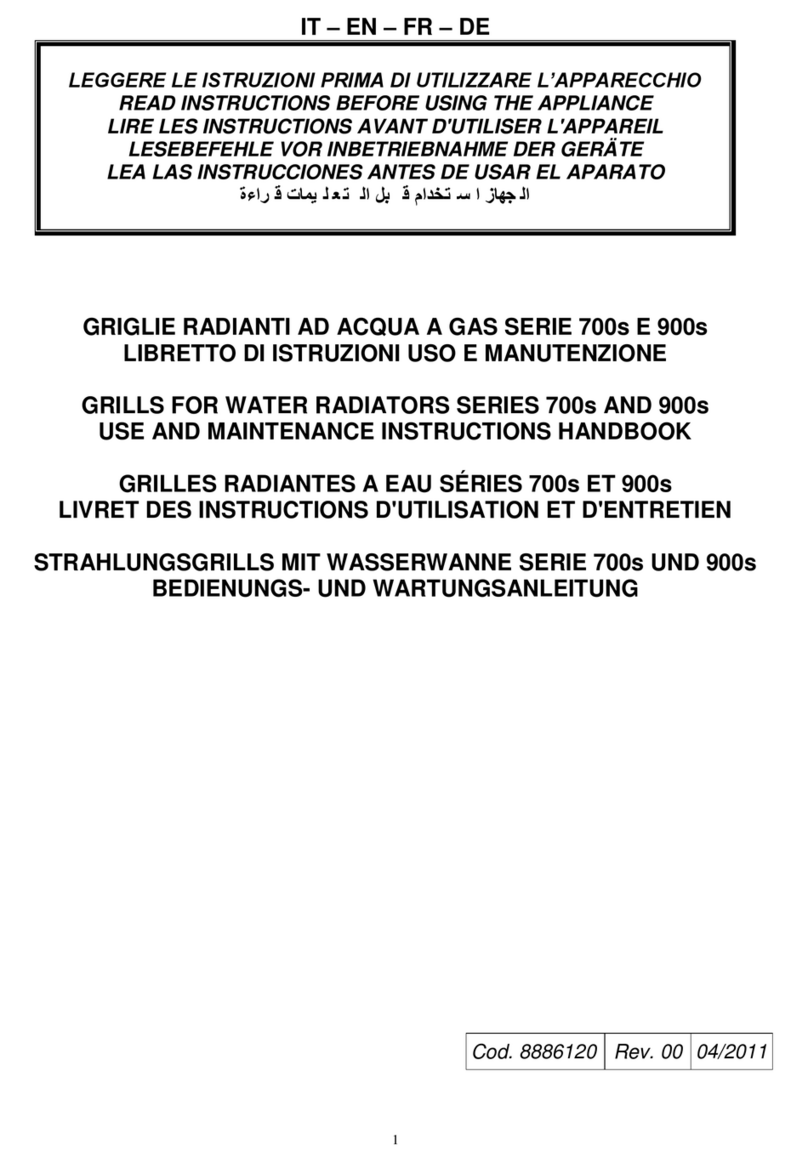
OFFCAR
OFFCAR 700s Series Instructions use and maintenance handbook
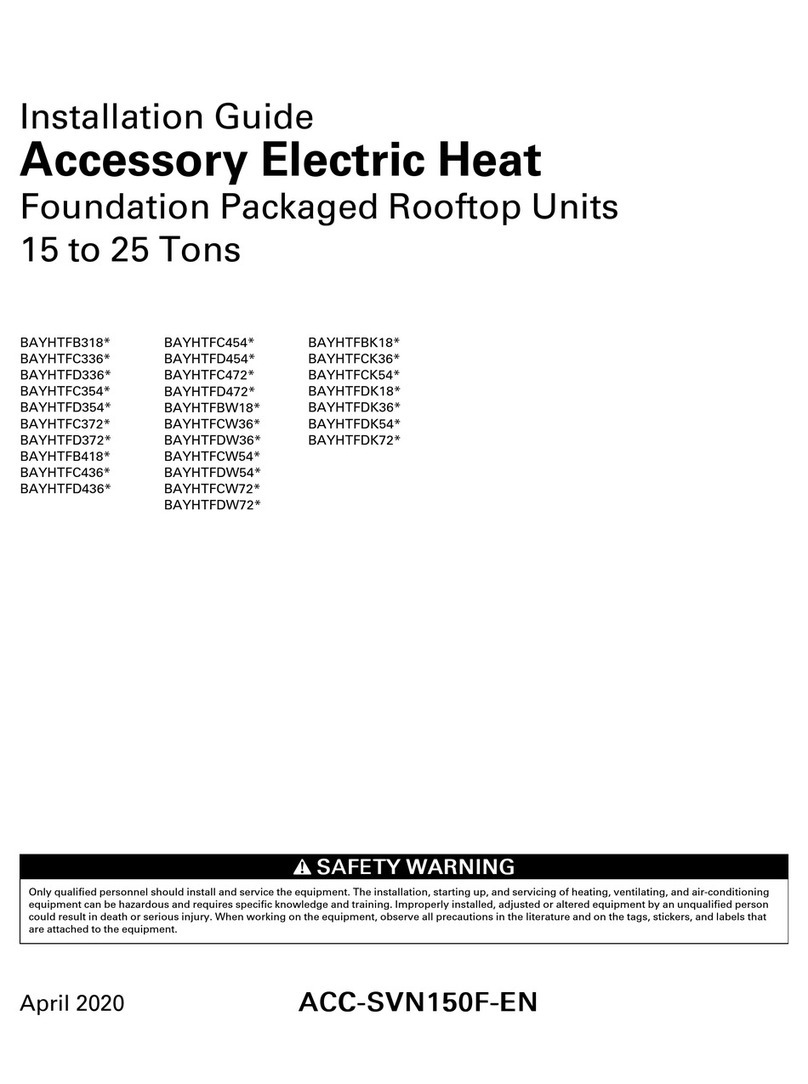
Trane
Trane BAYHTFB318 Series installation guide
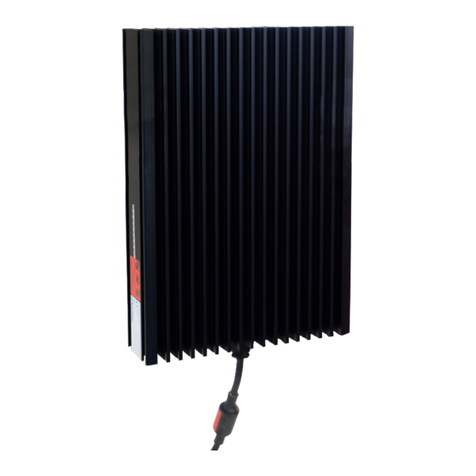
Intertec Data Systems
Intertec Data Systems SL MEGATHERM DE.A operating instructions
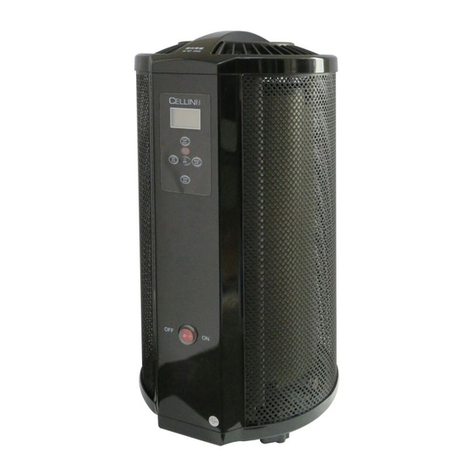
Cellini
Cellini MICA CMH20 user manual
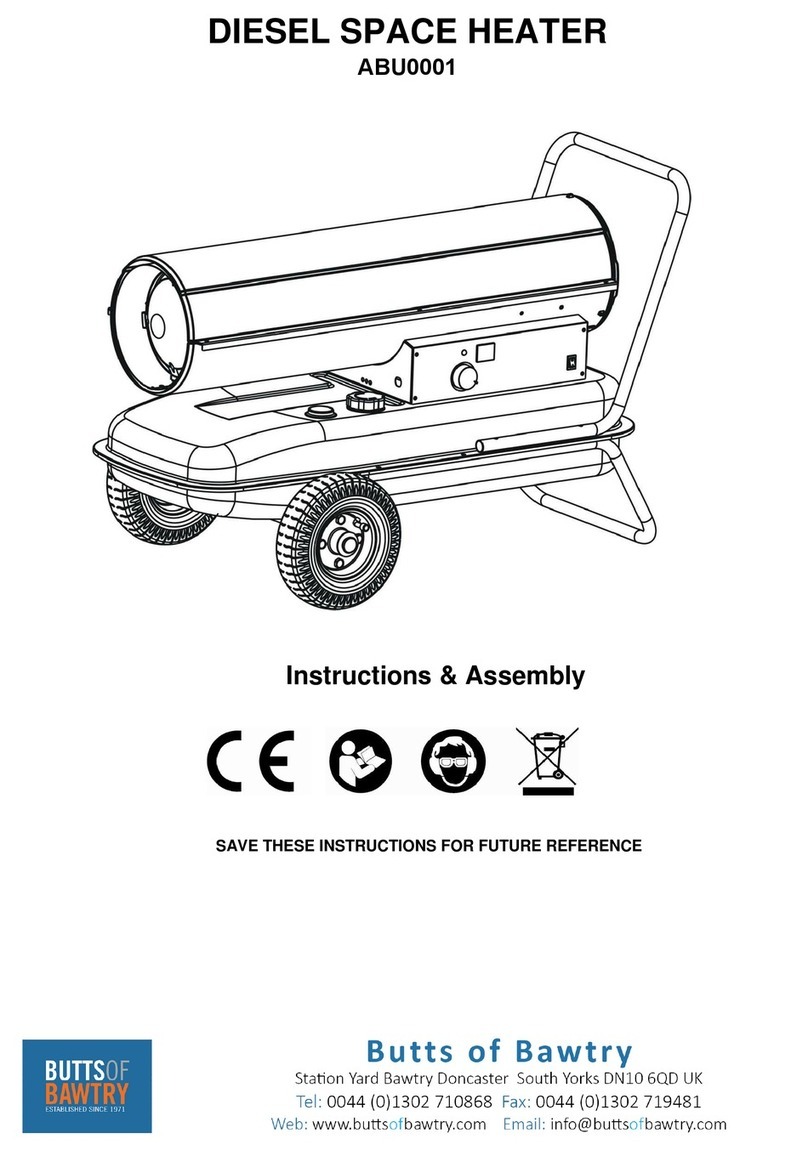
Butts of Bawtry
Butts of Bawtry ABU0001 Instructions & assembly
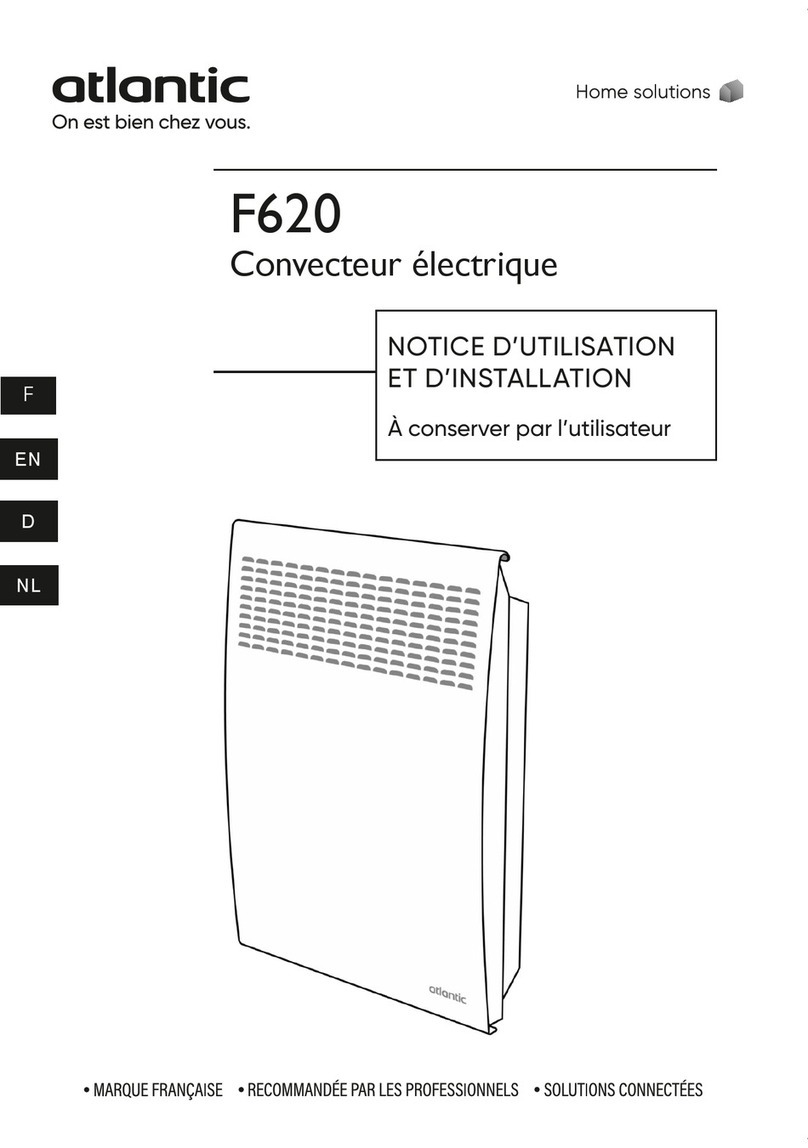
Atlantic
Atlantic F620 manual
